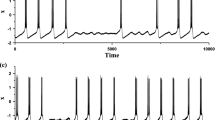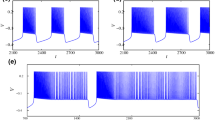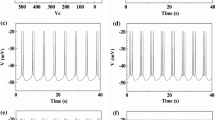Abstract
Coherence resonance (CR), which is typical nonlinear phenomenon that noise plays construct roles, has been widely investigated in single neurons at resting state instead of bursting behavior when noise free. In the present paper, multiple CRs evoked from bursting instead of resting state and the underlying bifurcation mechanism are studied in a theoretical neuron model composed of fast subsystem and slow variable, which is very important for the bursting neurons receiving strong synaptic noise in the central nervous system. With increasing noise intensity within a range, the bursting period decreases to induce the burst number increases firstly and then becomes irregular, which results in the increase firstly and then decrease in the corresponding peak of the power spectrum of membrane potentials, i.e., CR is evoked from bursting instead of resting state. With further increasing noise intensity, two other peaks exhibit CR phenomenon, one at middle frequency and middle noise intensity and the other at large frequency and strong noise intensity, which shows that multiple CRs are evoked from bursting. Furthermore, the bifurcation mechanism of the latter two resonant peaks is acquired with fast–slow variable dissection method. With increasing the value of slow variable, the fast subsystem exhibits a fold bifurcation of limit cycle and a subcritical Hopf bifurcation to a stable focus, and the imaginary part of the characteristic value of the focus increases, which implies that spikes evoked from the focus exhibit increasing frequency. The trajectory of the deterministic bursting in phase space locates between the two bifurcations and alternates between the coexisting limit cycle and focus of the fast subsystem. With increasing noise intensity, the value of slow variable of the stochastic bursting increases and moves to a range of the focus of the fast subsystem, and the spikes of the stochastic bursting are evoked from the focus by noise. Therefore, the stronger the noise intensity, the larger the value of slow variable, and the higher frequency the spikes, due to the changes of characteristic values, which is the cause that the peaks with middle and high frequency appear at middle and strong noise intensity, respectively. The results of the present paper extend the concept of CR to multiple CRs evoked from bursting, provide the bifurcation mechanism underlying the multiple CRs, and imply multiple chances to utilize noise to enhance information of bursting neurons.
























Similar content being viewed by others
References
Benzi, R., Sutera, A., Vulpiani, A.: Stochastic resonance in climatic change. J. Phys. A 14, L453–L457 (1981)
Gammaitoni, L., Hänggi, P., Jung, P., Marchesoni, F.: Stochastic resonance. Rev. Mod. Phys. 70, 223–287 (1998)
Lindnera, B., García-Ojalvob, J., Neiman, A., Schimansky-Geiere, L.: Effects of noise in excitable systems. Phys. Rep. 392, 321–424 (2004)
Simakov, D.S., Pérez-Mercader, J.: Noise induced oscillations and coherence resonance in a generic model of the nonisothermal chemical oscillator. Sci. Rep. 3, 2404 (2013)
McDonnell, M.D., Iannella, N., To, M.S., Tuckwell, H.C., Jost, J., Gutkin, B.S., Ward, L.M.: A review of methods for identifying stochastic resonance in simulations of single neuron models. Network 26(2), 35–71 (2015)
Sun, G., Jusup, M., Jin, Z., Wang, Y., Wang, Z.: Pattern transitions in spatial epidemics: mechanisms and emergent properties. Phys. Life Rev. 19, 43–73 (2016)
Longtin, A., Bulsara, A., Moss, F.: Time-interval sequences in bistable systems and the noise-induced transmission of information by sensory neurons. Phys. Rev. Lett. 67(5), 656–659 (1991)
Braun, H.A., Wissing, H., Schäfer, K., Hirsch, M.C.: Oscillation and noise determine signal transduction in shark multimodal sensory cells. Nature 367, 270–273 (1994)
McDonnell, M.D., Abbott, D.: What is stochastic resonance? Definitions, misconceptions, debates, and its relevance to biology. PLoS Comput. Biol. 5(5), e1000348 (2009)
Pikovsky, A.S., Kurths, J.: Coherence resonance in a noise-driven excitable system. Phys. Rev. Lett. 78, 775–778 (1997)
Longtin, A.: Autonomous stochastic resonance in bursting neurons. Phys. Rev. E 55(1), 868–876 (1997)
Douglass, J.K., Wilkens, L., Pantazelou, E., Moss, F.: Noise enhancement of information transfer in crayfish mechanoreceptors by stochastic resonance. Nature 365, 337–340 (1993)
Levin, J.E., Miller, J.P.: Broadband neural encoding in the cricket cereal sensory system enhanced by stochastic resonance. Nature 380, 165–168 (1996)
Gu, H., Zhao, Z., Jia, B., Chen, S.: Dynamics of on-off neural firing patterns and stochastic effects near a sub-critical Hopf bifurcation. PLoS One 10(4), e0121028 (2015)
Jia, B., Gu, H.: Dynamics and physiological roles of stochastic neural firing patterns near bifurcation points. Int. J. Bifurc. Chaos 27(7), 1750113 (2017)
Méndez-Balbuena, I., Huidobro, N., Silva, M., Flores, A., Trenado, C., Quintanar, L., Arias-Carrión, O., Kristeva, R., Manjarrez, E.: Effect of mechanical tactile noise on amplitude of visual evoked potentials: multisensory stochastic resonance. J. Neurophysiol. 114(4), 2132–2143 (2015)
van der Groen, O., Wenderoth, N.: Transcranial random noise stimulation of visual cortex: stochastic resonance enhances central mechanisms of perception. J. Neurosci. 36(19), 5289–5298 (2016)
Wuehr, M., Boerner, J.C., Pradhan, C., Decker, J., Jahn, K., Brandt, T., Schniepp, R.: Stochastic resonance in the human vestibular system\(-\)Noise\(-\)induced facilitation of vestibulospinal reflexes. Brain Stimul. 11(2), 261–263 (2018)
Angwin, A.J., Wilson, W.J., Arnott, W.L., Signorini, A., Barry, R.J., Copland, D.A.: White noise enhances new-word learning in healthy adults. Sci. Rep. 7(1), 13045 (2017)
Itzcovich, E., Riani, M., Sannita, W.G.: Stochastic resonance improves vision in the severely impaired. Sci. Rep. 7(1), 12840 (2017)
Hilliard, D., Passow, S., Thurm, F., Schuck, N.W., Garthe, A., Kempermann, G., Li, S.C.: Noisy galvanic vestibular stimulation modulates spatial memory in young healthy adults. Sci. Rep. 9(1), 9310 (2019)
Krauss, P., Metzner, C., Schilling, A., Schutz, C., Tziridis, K., Fabry, B., Schulze, H.: Adaptive stochastic resonance for unknown and variable input signals. Sci. Rep. 7(1), 2450 (2017)
Nobusako, S., Osumi, M., Matsuo, A., Fukuchi, T., Nakai, A., Zama, T., Shimada, S., Morioka, S.: Stochastic resonance improves visuomotor temporal integration in healthy young adults. PLoS One 13(12), e0209382 (2018)
Wu, S., Ren, W., He, K., Huang, Z.: Burst and coherence resonance in Rose-Hindmarsh model induced by additive noise. Phys. Lett. A 279(5–6), 347–354 (2001)
Gu, H., Yang, M., Li, L., Liu, Z., Ren, W.: Experimental observation of the stochastic bursting caused by coherence resonance in a neural pacemaker. NeuroReport 13(13), 1657–1660 (2002)
Gu, H., Yang, M., Li, L., Liu, Z., Ren, W.: Dynamics of autonomous stochastic resonance in neural period adding bifurcation scenarios. Phys. Lett. A 319(1–2), 89–96 (2003)
Yao, Y., Ma, J.: Weak periodic signal detection by sine-Wiener-noise-induced resonance in the FitzHugh-Nagumo neuron. Cogn. Neurodyn. 12(3), 343–349 (2018)
Zhou, C., Kurths, J., Hu, B.: Array-enhanced coherence resonance: nontrivial effects of heterogeneity and spatial independence of noise. Phys. Rev. Lett. 87(9), 098101 (2001)
Perc, M.: Spatial coherence resonance in excitable media. Phys. Rev. E 72, 016207 (2005)
Sun, X., Perc, M., Lu, Q., Kurths, J.: Spatial coherence resonance on diffusive and small-world networks of Hodgkin–Huxley neurons. Chaos 18(2), 023102 (2008)
Guo, D., Li, C.: Stochastic and coherence resonance in feed-forward-loop neuronal network motifs. Phys. Rev. E. 79, 051921 (2009)
Wang, Y., Ma, J., Xu, Y., Wu, F., Zhou, P.: The electrical activity of neurons subject to electromagnetic induction and gaussian white noise. Int. J. Bifurc. Chaos 27(02), 1750030 (2017)
Jia, Y., Gu, H.: Transition from double coherence resonances to single coherence resonance in a neuronal network with phase noise. Chaos 25(12), 123124 (2015)
Vilar, J.M.G., Rubí, J.M.: Stochastic multiresonance. Phys. Rev. Lett. 78(15), 2882–2885 (1997)
Jiang, Y.: Multiple dynamical resonances in a discrete neuronal model. Phys. Rev. E 71, 057103 (2005)
Liang, G., Cao, L., Wang, J., Wu, D.: Modulated stochastic multiresonance in a single-mode laser system driven by colored additive and multiplicative noises without external periodic force. Physica A 327(3–4), 304–312 (2003)
Yilmaz, E., Ozer, M., Baysal, V., Perc, M.: Autapse-induced multiple coherence resonance in single neurons and neuronal networks. Sci. Rep. 6, 30914 (2016)
Yang, X., Yu, Y., Sun, Z.: Autapse-induced multiple stochastic resonances in a modular neuronal network. Chaos 27(8), 083117 (2017)
Wang, Q., Perc, M., Duan, Z., Chen, G.: Delay-induced multiple stochastic resonances on scale-free neuronal networks. Chaos 19(2), 023112 (2009)
Wang, Q., Zhang, H., Perc, M., Chen, G.: Multiple firing coherence resonances in excitatory and inhibitory coupled neurons. Commun. Nonlinear Sci. Numer. Simul. 17(10), 3979–3988 (2012)
Perc, M.: Noise-induced spatial periodicity in excitable chemical media. Chem. Phys. Lett. 410(1–3), 49–53 (2005)
Perc, M.: Spatial decoherence induced by small-world connectivity in excitable media. New J. Phys. 7, 252–252 (2005)
Jung, P., Mayer-Kress, G.: Spatiotemporal stochastic resonance in excitable media. Phys. Rev. Lett. 74(11), 2130–2133 (1995)
Gu, H., Jia, B., Li, Y., Chen, G.: White noise-induced spiral waves and multiple spatial coherence resonances in a neuronal network with type I excitability. Physica A 392(6), 1361–1374 (2013)
Li, Y., Gu, H.: The influence of initial values on spatial coherence resonance in neuronal networks. Int. J. Bifurc. Chaos 25(8), 1550104 (2015)
Tateno, T., Pakdaman, K.: Random dynamics of the Morris–Lecar neural model. Chaos 14, 511–530 (2004)
Gu, H., Zhang, H., Wei, C., Yang, M., Liu, Z., Ren, W.: Coherence resonance induced stochastic neural firing at a saddle-node bifurcation. Int. J. Mod. Phys. B 25(29), 3977–3986 (2011)
Jia, B., Gu, H., Li, L., Zhao, X.: Dynamics of period-doubling bifurcation to chaos in the spontaneous neural firing patterns. Cogn. Neurodyn. 6(1), 89–106 (2012)
Gu, H., Ren, W., Lu, Q., Wu, S., Chen, W.: Integer multiple spiking in neuronal pacemakers without external periodic stimulation. Phys. Lett. A 285, 63–68 (2001)
Kim, J.H., Lee, H.J., Min, C.H., Lee, K.J.: Coherence resonance in bursting neural networks. Phys. Rev. E 92(4), 042701 (2015)
Lisman, J.E.: Bursts as a unit of neural information: making unreliable synapses reliable. Trends Neurosci. 20(1), 38–43 (1997)
Izhikevich, E.M.: Neural excitability, spiking and bursting. Int. J. Bifurc. Chaos 10(6), 1171–1266 (2000)
Izhikevich, E.M.: Dynamical Systems in Neuroscience: The Geometry of Excitability and Bursting. MIT Press, Cambridge (2007)
Del Negro, C.A., Hsiao, C.F., Chandler, S.H., Garfinkel, A.: Evidence for a novel bursting mechanism in rodent trigeminal neurons. Biophys. J. 75, 174–182 (1998)
Li, Y., Gu, H.: The distinct stochastic and deterministic dynamics between period-adding and period-doubling bifurcations of neural bursting patterns. Nonlinear Dyn. 87(4), 2541–2562 (2017)
Wu, F., Gu, H., Li, Y.: Inhibitory electromagnetic induction current induced enhancement instead of reduction of neural bursting activities. Commun. Nonlinear Sci. Numer. Simul. 79, 104924 (2019)
Li, Y., Gu, H., Ding, X.: Bifurcations of enhanced neuronal bursting activities induced by the negative current mediated by inhibitory autapse. Nonlinear Dyn. 97(4), 2091–2105 (2019)
Cao, B., Guan, L., Gu, H.: Bifurcation mechanism of not increase but decrease of spike numbers within a neural burst induced by excitatory effect. Acta Phys. Sin. 67(24), 240502 (2018). (in chinese)
Wu, F., Gu, H.: Bifurcations of negative responses to positive feedback current mediated by memristor in neuron model with bursting patterns. Int. J. Bifurc. Chaos 30(4), 2030009 (2020)
Mysin, I.E., Kitchigina, V.F., Kazanovich, Y.: Modeling synchronous theta activity in the medial septum: key role of local communications between different cell populations. J. Comput. Neurosci. 39, 1–16 (2015)
Wang, X.: Pacemaker neurons for the theta rhythm and their synchronization in the septohippocampal reciprocal loop. J. Neurophysiol. 87, 889–900 (2002)
Colom, L.V., Castaneda, M.T., Reyna, T., Hernandez, S., Garrido-Sanabria, E.: Characterization of medial septal glutamatergic neurons and their projection to the hippocampus. Synapse 58(3), 151–164 (2005)
Hangya, B., Borhegyi, Z., Szilágyi, N., Freund, T.F., Varga, V.: GABAergic neurons of the medial septum lead the hippocampal network during theta activity. J. Neurosci. 29(25), 8094–8102 (2009)
Mannella, R., Palleschi, V.: Fast and precise algorithm for compute simulation of stochastic differential equations. Phys. Rev. A 40, 3381–3386 (1989)
Ermentrout, B.: Simulating, analyzing, and animating dynamical systems: a guide to XPPAUT for researchers and students. SIAM, Philadelphia (2002)
Hu, G., Ditzinger, T., Ning, C.Z., Haken, H.: Stochastic resonance without external periodic force. Phys. Rev. Lett. 71(6), 807 (1993)
Semenova, N., Zakharova, A., Anishchenko, V., Schöll, E.: Coherence-resonance chimeras in a network of excitable elements. Phys. Rev. Lett. 117(1), 014102 (2016)
Moss, F., Ward, L.M., Sannita, W.G.: Stochastic resonance and sensory information processing: a tutorial and review of application. Clin. Neurophysiol. 115(2), 267–281 (2004)
McDonnell, M.D., Ward, L.M.: The benefits of noise in neural systems: bridging theory and experiment. Nat. Rev. Neurosci. 12(7), 415–426 (2011)
Faisal, A.A., Selen, L.P., Wolpert, D.M.: Noise in the nervous system. Nat. Rev. Neurosci. 9(4), 292–303 (2008)
Yu, H., Zhang, L., Guo, X., Wang, J., Cao, Y., Liu, J.: Effect of inhibitory firing pattern on coherence resonance in random neural networks. Phys. A 490, 1201–1210 (2018)
Zhang, X., Gu, H., Guan, L.: Stochastic dynamics of conduction failure of action potential along nerve fiber with Hopf bifurcation. Sci. China Technol. Sci. 62(9), 1502–1511 (2019)
Ma, J., Wang, C., Jin, W., Wu, Y.: Transition from spiral wave to target wave and other coherent structures in the networks of Hodgkin–Huxley neurons. Appl. Math. Comput. 217(8), 3844–3852 (2010)
Author information
Authors and Affiliations
Corresponding author
Ethics declarations
Conflict of interest
The authors declare that they have no conflict of interest.
Additional information
Publisher's Note
Springer Nature remains neutral with regard to jurisdictional claims in published maps and institutional affiliations.
This work was sponsored by the National Natural Science Foundation of China (Grant Numbers: 11872276, 11572225, 11802086)
Rights and permissions
About this article
Cite this article
Guan, L., Gu, H. & Jia, Y. Multiple coherence resonances evoked from bursting and the underlying bifurcation mechanism. Nonlinear Dyn 100, 3645–3666 (2020). https://doi.org/10.1007/s11071-020-05717-0
Received:
Accepted:
Published:
Issue Date:
DOI: https://doi.org/10.1007/s11071-020-05717-0




